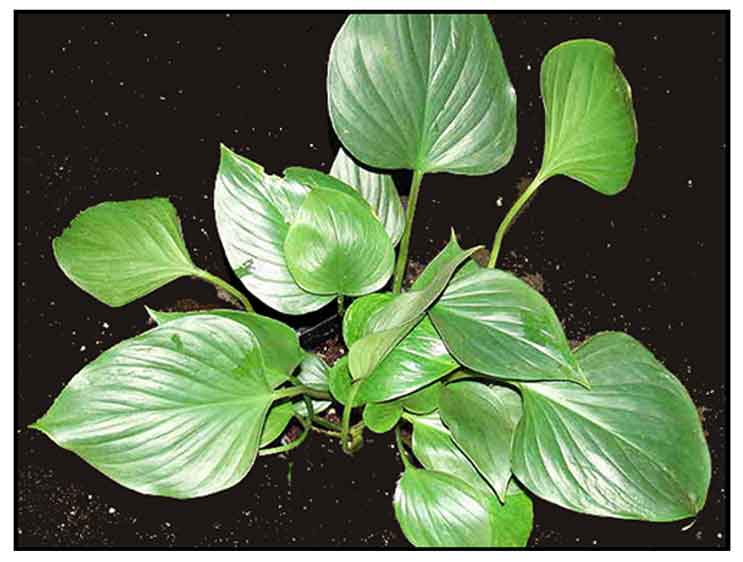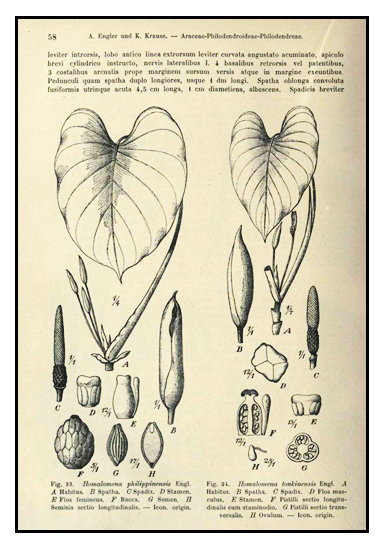
Family • Araceae
Payau
Homalomena philippinensis Engl.
| Scientific names | Common names |
| Homalomena philippinensis Engl. | Alipaiu (Tag.) |
| Homalomena rubescens var. latifolia Engl. | Alipayo (Tag.) |
| Alopayi (Tag.) | |
| Alupayi (Tag.) | |
| Hayau (Sub.) | |
| Payau (Tag.) | |
| Payaw (Tag.) | |
| Phayaw (Sub.) | |
| Salet (Pang.) | |
| Salet-ñga-nalabaga (Tag.) | |
| Tahig (Bik.) | |
| Homalomena philippinensis Engl. is an accepted species. KEW: Plants of the World Online | |
Updated April 2023 / June 2018 / October 2015
![]()
 |
PHOTOS / ILLUSTRATIONS |
| IMAGE SOURCE: Homalomena sp. (emerald gem habit) / File:Starr 070906-8753 Homalomena sp..jpg / Forest & Kim Starr / 6 Sept 2007 / click on photo to go to source page / Wikipedia |
| OTHER IMAGE SOURCE: Drawing of leaves and flowers / Photograph by: Engler, H.G.A., Das Pflanzenreich, Araceae - Philodendroideae - Philodendreae - Homalomeniae / Attribution-NonCommercial-NoDerivatives 4.0 International (CC BY-NC-ND 4.0) / Useful Tropical Plants |
| Additional
Sources and Suggested Readings (1) Homalomena philippinensis Engl. / Synonyms / The Plant List (2) Minor products of Philippine forests / William H. Brown, Vol 1, No 3 / Manila Bureau of Printing 1921 (3) Ethnobotany of Medicinal Plants Used by the Subanen Tribe of Lapuyan, Zamboanga del Sur / Jhoan Rhea L Pizon, Olg M Nuñeza, Mylene M Uy, W Senarath / Bulletin of Environment, Pharmacoly, and Life Sciences, April 2016; 5(5): pp 53-67 (4) Homalomena / Wikipedia (5) Homalomena / The Plant List (6) SECONDARY METABOLITE SCREENING AND ANTIMICROBIAL ACTIVITY OF Homalomena philippinensis Engl. ex Engl. & K. Krause (ARACEAE) RHIZOME EXTRACT / Chinee Anne Marie C Gaba and Zsazsa D Ortilla / Partial Fulfillment of BS Degree in Human Biology: April 2016 (7) An Ethnobotanical Study of Medicinal Plants and Perceptions on Plant Biodiversity Conservation in Leyte, Philippines / Janice Susaya Garcia, Nanette Borja, Janice B Sevilla-Nastor, Jessica D Villanueva, Nicolas Peyraube / Journal of Human Ecology, Jam-Dec 2018, Issue 7: pp 26-42 (8) Table 4 Medicinal plants used by the Agusan Manobo in Agusan del Sur, Philippines / Quantitative ethnopharmacological documentation and molecular confirmation of medicinal plants used by the Manobo tribe of Agusan del Sur, Philippines / Journal of Ethnobiology and Ethnomedicine |
• |
DOI: It is not uncommon for links on studies/sources to change. Copying and pasting the information on the search window or using the DOI (if available) will often redirect to the new link page. (Citing and Using a (DOI) Digital Object Identifier) |
| List of Understudied Philippine Medicinal Plants |
• |
 |



